
The truth is that most job applications never even make it to a human recruiter. The reason? Applicant Tracking Systems (ATS) that do the initial screening.
These pesky robots are often why many candidates get rejected without a second thought.
So, if you want your application to make it to a hiring manager’s desk, you need to write an ATS resume.
Getting past the ATS doesn’t have to be hard though – in this guide, we’ll teach you how to do it.
We’re going to cover:
- What is an Applicant Tracking System (ATS)?
- 7 Steps to Create an ATS Resume
- 16+ ATS Resume Templates for 2026
…and more!
Let’s begin.

Want to create your ATS resume without missing a beat? Use one of our ATS-friendly templates!
Just follow the instructions in our article while using our free resume builder.
What is an Applicant Tracking System (ATS)?
An Applicant Tracking System (ATS) is a specialized software that helps employers and recruiters streamline recruiting. It serves as a central database for managing job applications, resumes, and candidates’ information.
When you submit your application, the ATS automatically collects, scans, and analyzes your resume and any other documents, such as your cover letter. It searches for specific keywords, qualifications, and experiences that match the job requirements set by the employer.
Then, based on this analysis, the ATS ranks and sorts all the candidates, and the most promising ones immediately make it to the top of the list.
But most job applications don’t go that far at all.
Over 70% of resumes don’t make it to a hiring manager’s desk! So, creating an ATS-friendly resume is crucial if you want to land that job interview.
Why Do So Many Companies Use ATS?
While you might think it’s unfair for employers to use ATS, big companies have good reason to do so.
Since the rise of online job hunting, a single job advertisement can attract hundreds of applications. That’s pretty overwhelming for the hiring managers who have to go through each of those resumes manually.
So, the ATS helps streamline the initial hiring process and saves hiring managers looking for candidates with specific skills or experiences time. According to HackerEarth, 95% of professionals say that ATS has improved their company.
Not to mention that the ATS standardizes the hiring process. When a robot is evaluating you on the same criteria as everyone else, there is no room for unconscious bias.
Applicant tracking systems also provide valuable data and analytics on the hiring processes, such as what time it takes them to hire someone or what the source of the new hire is. This way, companies can refine their hiring strategies and improve the recruitment process with every position they open.
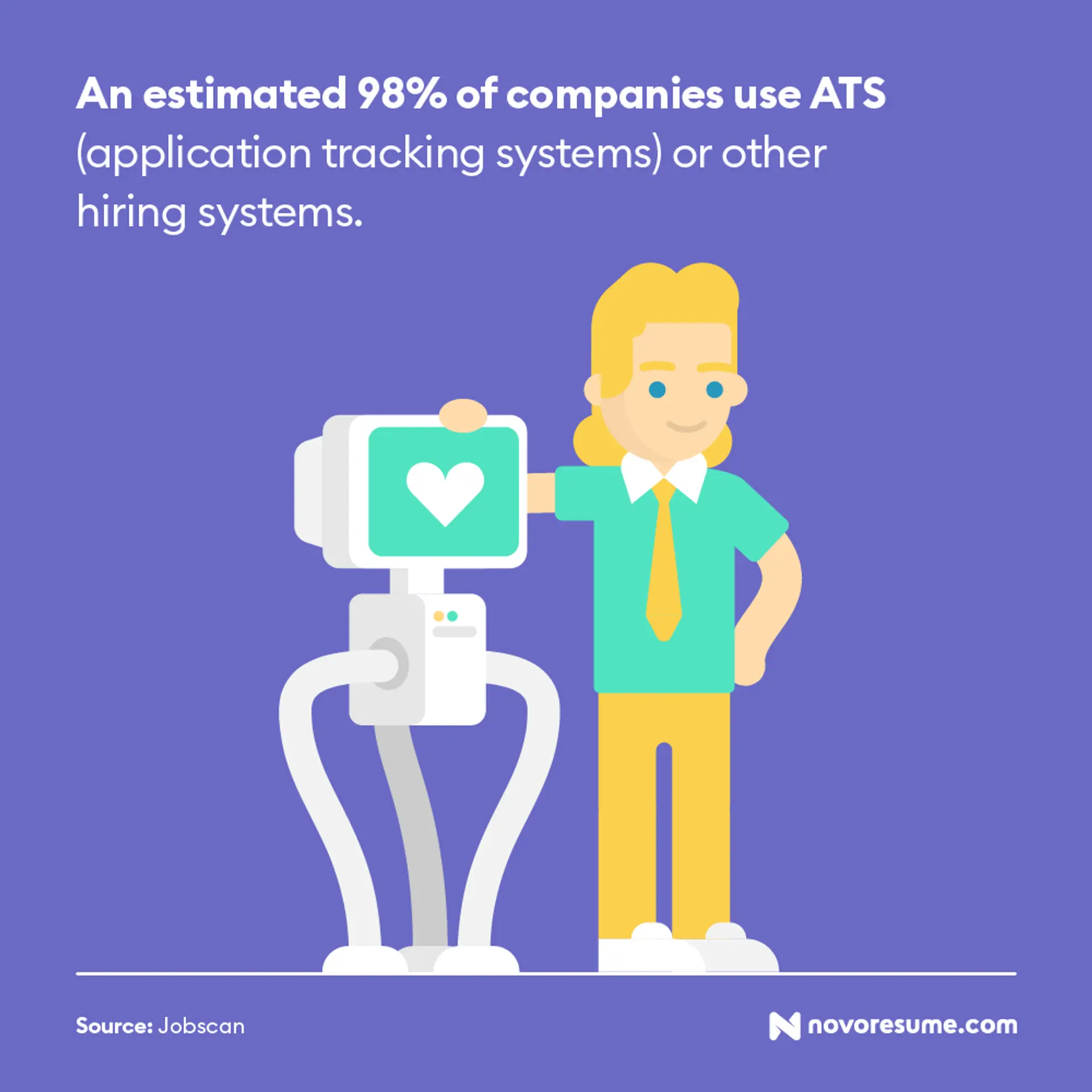
How Does the ATS Work?
Applicant tracking systems can be complex or simple, but most operate on the same principles.
First, the company creates a job posting and “feeds” it to the ATS.
Then that gets published on company websites, job boards, hiring platforms, and so on.
When you apply for that job, the ATS immediately scans it and divides the text into different resume sections.
The entire time, the ATS is actively looking for specific keywords and qualifications to see whether you match what the employer is looking for.
Let’s illustrate this with an example:
You’re applying for a job as a tax manager.
In that case, your resume summary might look something like this:
Tax Manager Resume Summary Example
- “Highly driven tax manager with 5+ years of financial experience in managing tax returns and affairs. Proven experience of success, employer satisfaction, and strong communication skills.”
Just from this paragraph, the ATS is going to read:
- Tax manager
- 5+ years of experience
- Tax returns and affairs
- Employer satisfaction
- Strong communication skills
Then, it’s going to match it to the list of requirements for the job.
ATS Requirements Example
- ✅ Tax manager
- ✅ 5+ years of experience
- ✅ Employer satisfaction
- ✅ Communication skills
- ❌ BA in Finance or Accounting
- ❌ Microsoft Office
As you can see, the ATS ranks your resume depending on how well it matches the requirements set by the employer. If your resume doesn’t match the basic list of requirements for the job, it’s automatically discarded.
💡
Quick Tip
Don’t have a resume yet? Check out our detailed guide on how to make a resume here!
What Is an ATS Resume?
An ATS resume is a resume that's optimized to breeze through an Applicant Tracking System.
It's designed to present your information in a way that makes it easy for the software to match your skills and experience with the job requirements, word for word, and easy to read by both the ATS and human recruiters.
An ATS resume uses a clean, simple format with standard section headings. It includes relevant keywords from the job description and focuses on your most important qualifications, without fancy formatting or graphics that might confuse the ATS.
ATS Resume Example
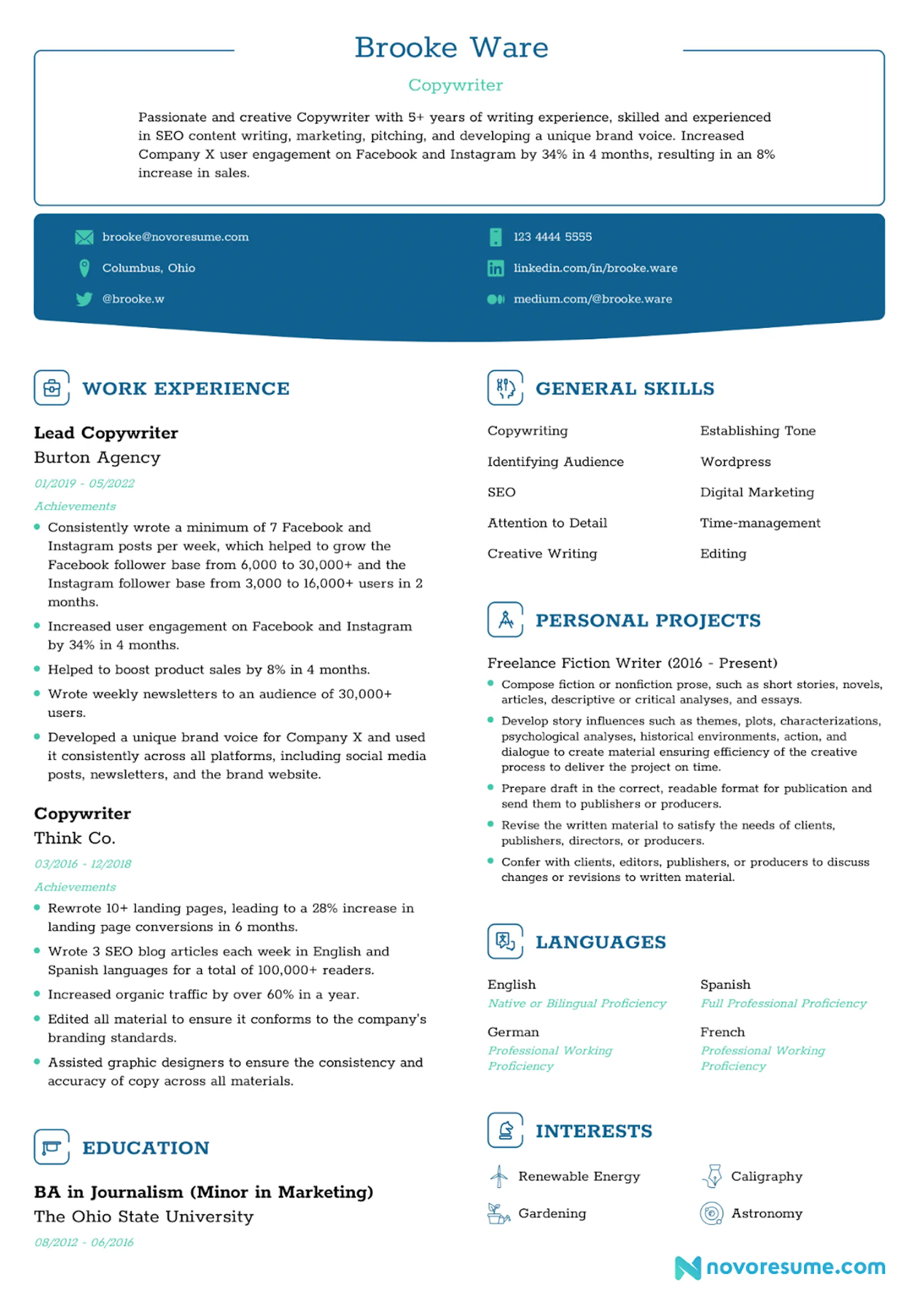
Now that’s a perfect ATS resume!
Let’s take a look at what it does right:
- One page. The candidate keeps everything short and sweet. ATS prefer concise resumes, making it easier for human HRs to skim your qualifications.
- Reverse-chronological format. This format puts your most recent work experience front and center; this is exactly what the ATS and hiring managers want to see.
- Clear section headings. This resume isn’t too creative. Standard labels like "Work Experience" and "Skills" are just what the ATS needs.
- Detailed work experience. The work experience section is fleshed out with relevant accomplishments and responsibilities, which is great since the ATS is hunting for keywords that match the job description.
- Tailored skills section. The candidate focuses on the skills mentioned in the job ad to keep their resume as relevant as possible.
- Simple layout. The resume doesn’t bother with fancy designs and graphics that the ATS can’t understand. A clean, straightforward layout with standard fonts makes it reader-friendly for machines and humans.
How to Create an ATS Resume (Step-By-Step)
Now that you know how the ATS works, we’ll teach you how to beat it.
Just follow the steps we’ve outlined:
#1. Pick the Right Resume Format
First, you should pick a resume format before you start filling in your ATS resume.
There are three different resume formats to choose from:
- Chronological (also called reverse-chronological)
- Functional (also called skill-based)
- Combination (a combination of the two above)
In most cases, we recommend sticking to the reverse-chronological resume format for your ATS resume.
This is the most popular format worldwide, so it’s what hiring managers expect to see and what the ATS will probably expect.
The reverse-chronological format highlights your most recent work experience and achievements first. So, it’s perfect for emphasizing your strengths in front of the ATS and human hiring managers down the line.
Here’s what the reverse-chronological resume format looks like:
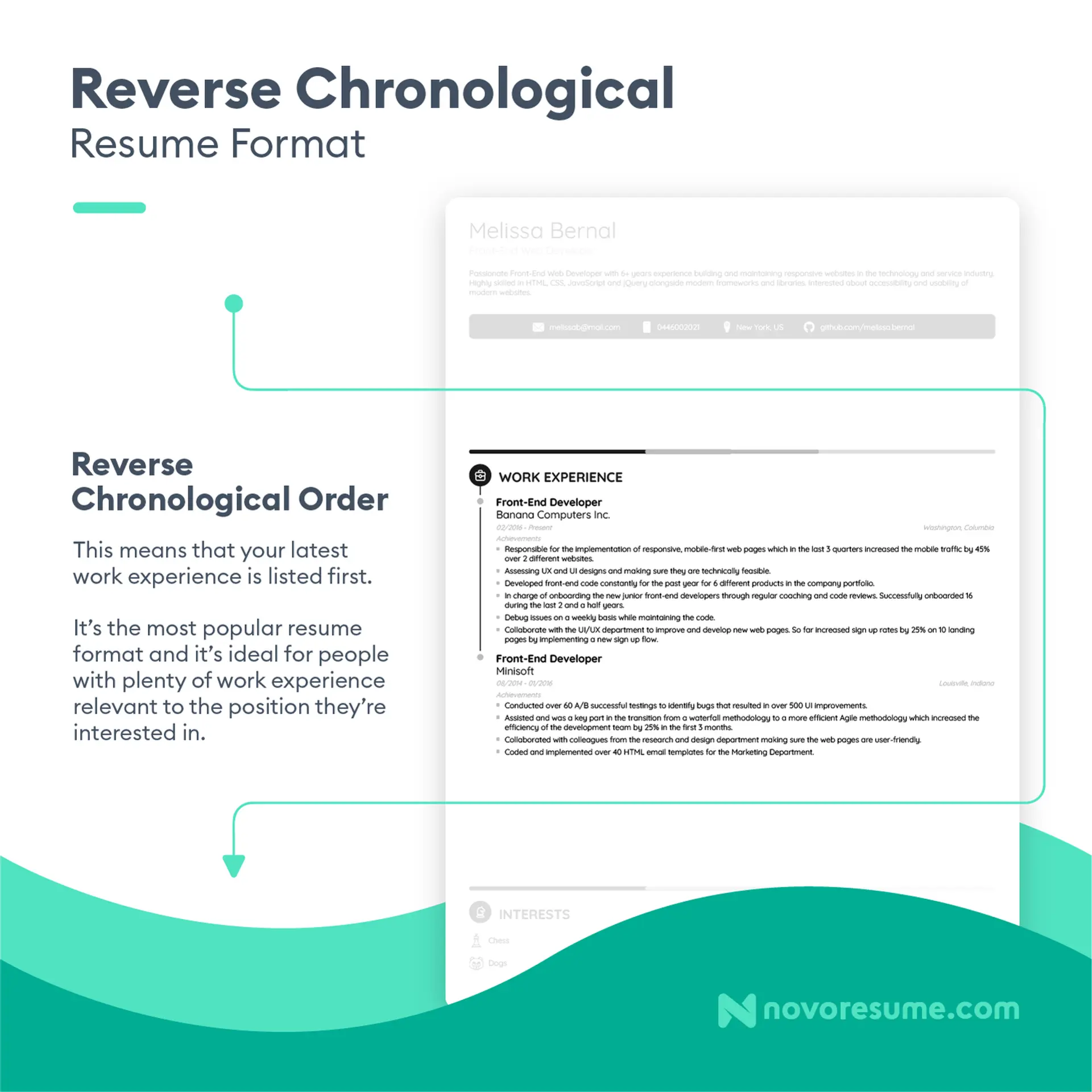
#2. Adjust the Layout
Once your resume’s format is out of the way, it’s time to figure out the layout.
This part can affect how the ATS scans your resume and what the hiring manager thinks about it.
If your resume isn’t formatted well, the ATS might have trouble scanning it. Not to mention, this part is important for human HRs, too. You want your resume to make a great first impression, and not look like a messy, cluttered document the hiring manager will skip in a heartbeat.
Here are some resume layout tips to help your ATS resume:
- Fix the margins. Set the page margins to one inch on all sides. Any more than that, your resume will look too cluttered, while any less might make it look stretched out.
- Set the line spacing. The standard line spacing is 1.0 between text and 1.15 between double lines and after subheadings, so adjust it accordingly on your resume.
- Choose a professional font. There are plenty of resume fonts to choose from but you want to ensure your resume is easy to read by the ATS and hiring manager. We recommend choosing something professional but not overused, like Lora or Roboto.
- Adjust the font size. Keep your headings at about 14 to 16 pt, and make sure your text is between 10 and 12 pt.
- Use bullet points. Both the ATS and human hiring managers prefer bullet points to bulky paragraphs. This makes finding the keywords and phrases they’re looking for in candidates easier.
- Avoid graphics. Most ATS can’t scan graphics, so any logos, charts, or pictures aren’t going to register right. Keep your resume simple by avoiding them and focusing on text instead. Novorésumé's templates are exported as text-based PDF files, meaning all your content will be parsed by ATS.
Or Use a Resume Template Instead
Making an ATS resume from scratch can be tough.
You’ll spend hours adjusting margins and experimenting with font styles and sizes, all while trying to make your resume look good and not spill over to page two.
But here's the good news: you can skip all the hassle with one of our free resume templates!
Each template is crafted in collaboration with HR experts worldwide to ensure it's easy to read, ATS-friendly, and stylish. Choose a template that matches your style and industry and use our free resume builder to finish your job application in minutes!
Check out how one of our templates compares to a standard text editor resume:
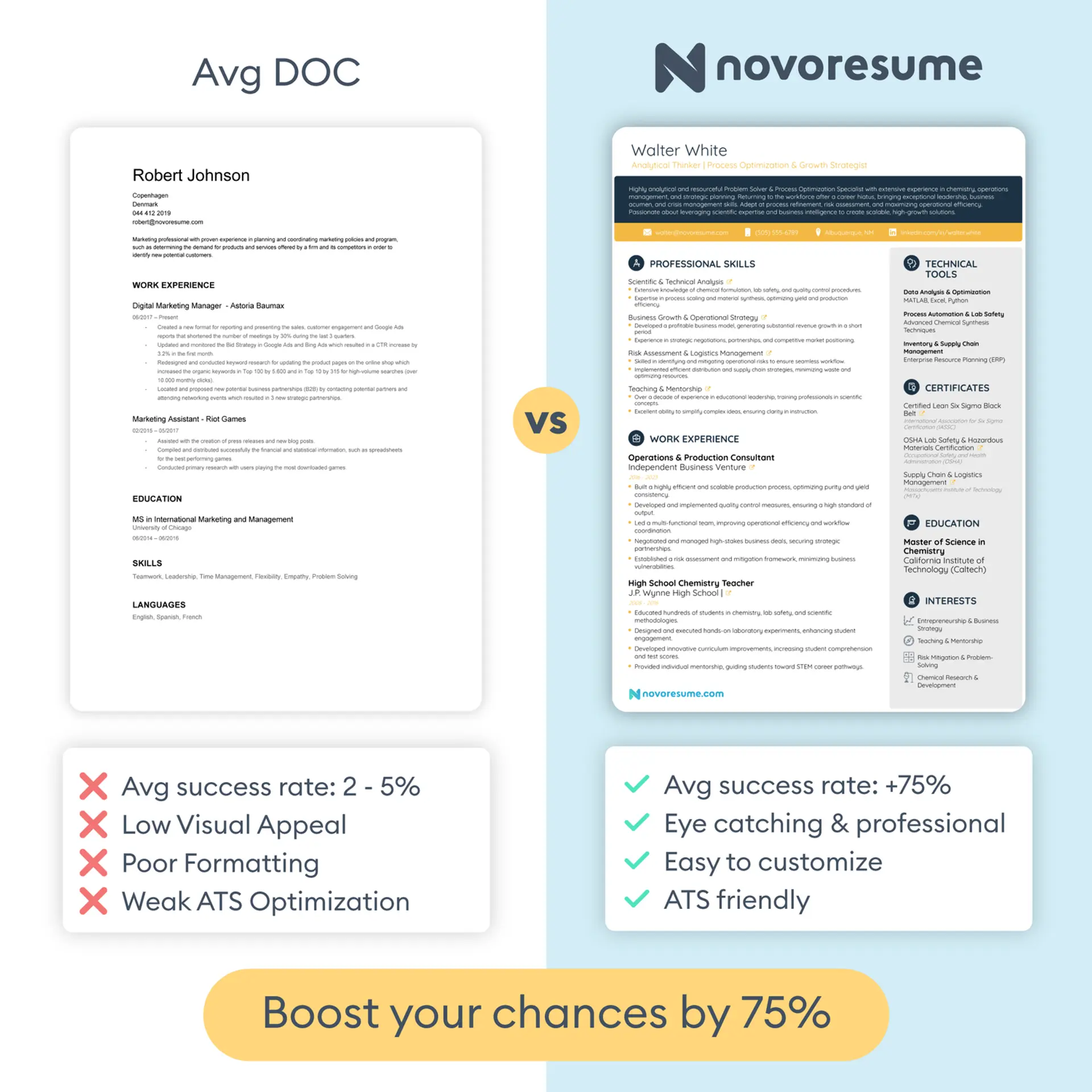
#3. Label Your Sections Correctly
Remember to use the right titles for your resume sections when creating an ATS resume.
This might seem like a detail, but it can alter how the ATS reads and categorizes your information.
If you stick to standard, clear section headings like "Work Experience," "Skills," and "Education," you’re all set.
But if you get creative with names like "Professional Journey" or "Academic Journey," you’re in for an automatic rejection.
These section titles might sound interesting but they will likely confuse the ATS. Keep in mind that ATS is programmed to look for specific section titles. It will know where to pull information from your resume only when it finds them.
So, if you use non-standard headings, the ATS might misclassify your information or even skip over important details.
Not to mention that the human hiring managers will appreciate it, too. Labeling your resume sections clearly makes it easier for employers to find what they’re looking for and increases your odds of getting an interview.
#4. Tailor Your Resume with Keywords
The most crucial step to getting your resume past the ATS and into the hands of a hiring manager is to learn how to use keywords effectively.
ATS software scans your resume for specific words and phrases related to the job you're applying for, and it’s looking for a match between your skills and experiences and the job requirements.
So, if your resume doesn't contain the right keywords, the ATS will filter it out before a human sees it.
Here’s how to effectively use keywords in your ATS resume:
- Carefully read the job description and find any skills, action verbs, and other requirements.
- Incorporate these keywords naturally throughout your resume.
- Don’t stuff the keywords everywhere - your resume should still flow naturally.
While keywords make or break your ATS score, in the end, a human will judge your resume. You need to strike a balance between optimizing for the ATS and creating a compelling narrative of why you’re the right person for the job.
Now, let’s look at the different places where you can add resume keywords.
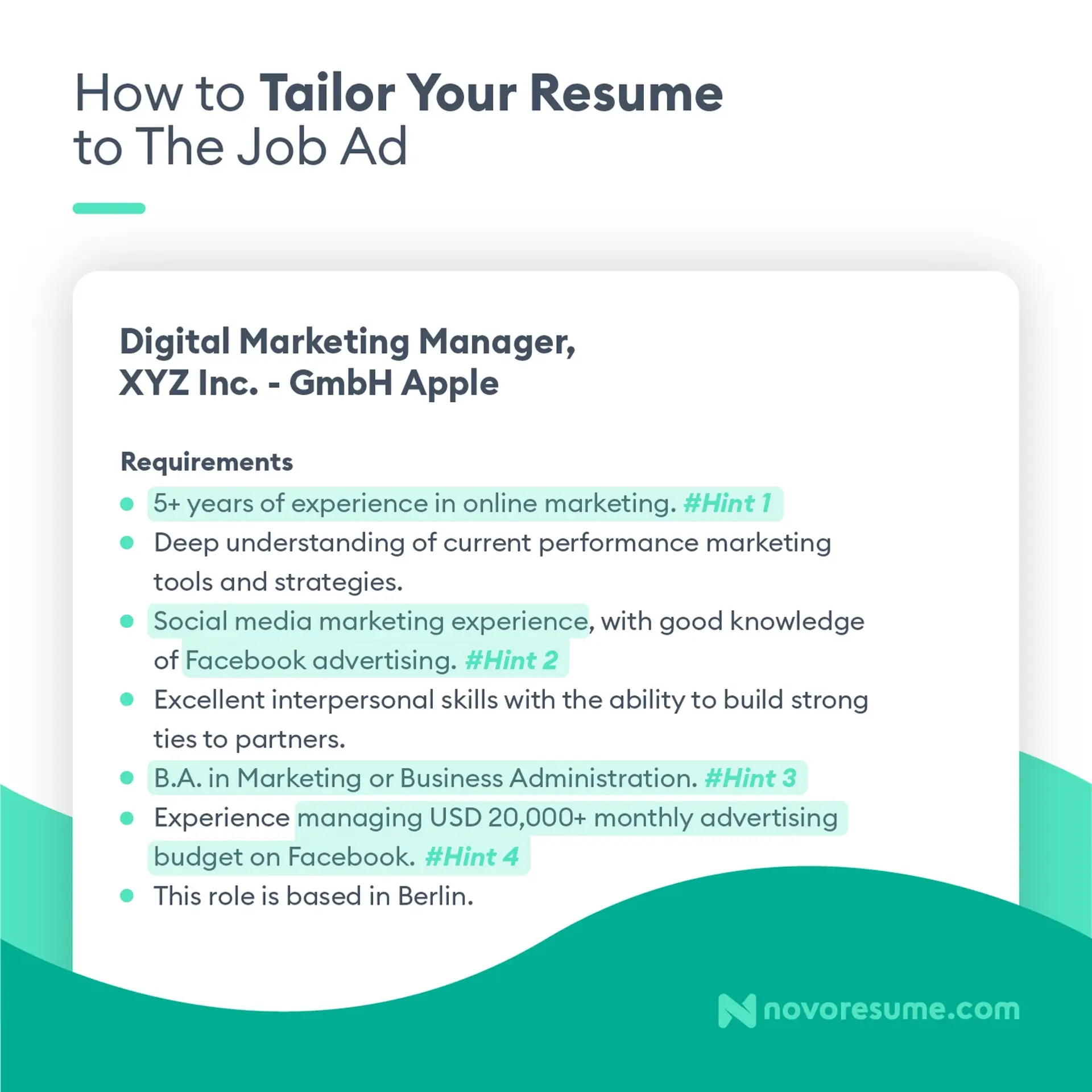
- Resume summary or objective. This brief paragraph goes on top of your resume and lets the hiring manager know what you offer at a glance. Include a few crucial skills or qualifications that match the job description here. (E.g.: Digital marketer with 5+ years of experience. Looking to help Company XYZ with their social media management.)
- Work experience. Try to mirror the language of the job ad when describing your roles and achievements. You can also use industry-specific terms relevant to the position. (E.g.: Spearheaded a successful social media marketing campaign that boosted engagement by 23% over three weeks.)
- Skills section. Make sure you list both hard and soft skills that match the job requirements. (E.g.: social media marketing, Facebook advertising, budget management)
- Education. This should be short and sweet since the ATS mostly looks for your degree and major. (E.g.: BA in Business Administration) However, if you’re a recent graduate, you can include some relevant coursework, projects, or thesis topics that align with the job requirements.
💡
Quick Tip
Try not to use too many acronyms since some ATS can’t recognize them. We recommend you both spell out the full phrase and add the acronym. E.g.: Bachelor of Public Administration (BPA).
#5. Stick to One Page
When it comes to resume length, one page is the golden rule.
On one hand, industry studies have shown that longer resumes tend to perform better with ATS compared to shorter ones. This is because they reach keyword density faster, so that might give them a potential edge in the initial screening process.
But on the other hand, your resume needs to be appealing to human eyes, too.
Once your resume passes the ATS, a hiring manager will review it. And let's face it, most hiring managers are pressed for time and prefer concise, easy-to-skim resumes that follow the ten-second resume rule.
So, a well-tailored one-page resume is your best bet. It forces you to be selective, highlighting only your most relevant and impressive qualifications, and ensures that every word counts for the ATS.
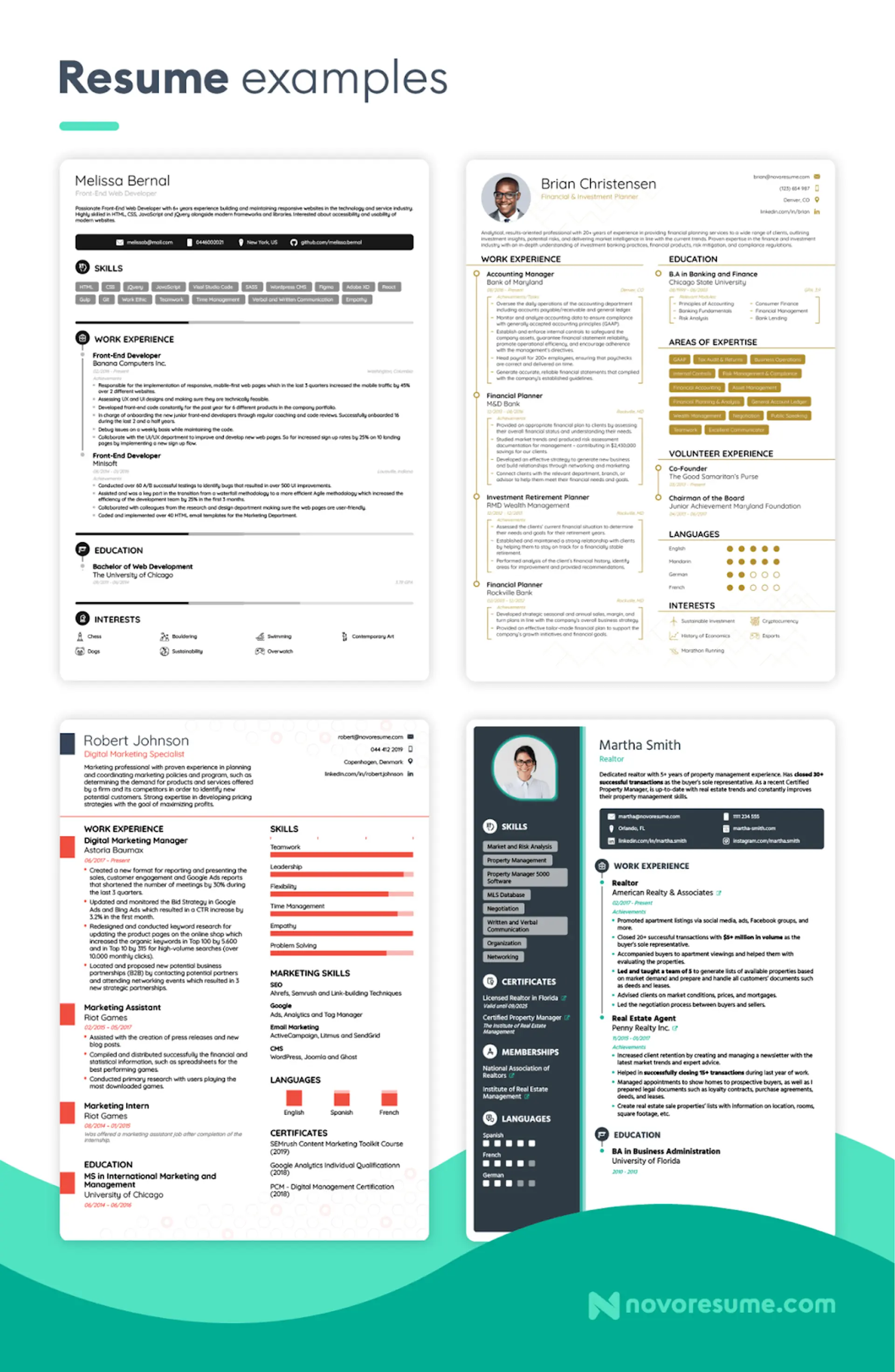
#6. Choose the Appropriate File Type
Once you finish writing your resume, it’s time to export it as the right file type.
For 99% of cases, that file type is a PDF.
PDFs are universal and can be read by most modern ATS, plus they keep your resume’s contents neatly formatted and don’t mess up the design. The hiring manager can open your PDF resume across any software or device and it’ll look exactly as you intended.
However, there are some exceptions.
Some older ATS models can’t read PDF files, so sending it as one might get your resume rejected.
If the company uses an older ATS, they’ll probably specify what format to send your resume as. Make sure you check the job ad in case they mention it somewhere.
Only send your resume as a .DOC or .DOCX file if the company explicitly asks you to. If they haven’t specified anything, send it in as a PDF.
#7. Include a Cover Letter
The final secret step that can give you an edge against the ATS is to always include a cover letter with your resume.
Even if the job ad doesn’t explicitly require a cover letter, you should still send one. Writing a cover letter shows the hiring manager that you’re willing to go the extra mile for the job, which can set you apart from candidates who only submit the bare minimum.
Not to mention that a well-crafted cover letter can significantly boost your ATS score. Like your resume, the cover letter can be optimized with relevant keywords and phrases from the job description, which the ATS picks up on.
Writing a cover letter also lets you elaborate on experiences or qualifications you didn’t have the space to explain on your resume. It’s the perfect place to highlight impressive achievements that are particularly relevant to the role or express your knowledge of the company or passion for the industry.
How to Run an ATS Check on Your Resume with ChatGPT
Are you done writing your ATS resume? Awesome! Now, you just need to double-check that you’ve hit all the checkmarks the ATS will look for.
The easiest way to make sure your resume is ATS-optimized is by asking ChatGPT for a little help.
All you have to do is log into ChatGPT, start a new chat, and explain that you need an ATS check.
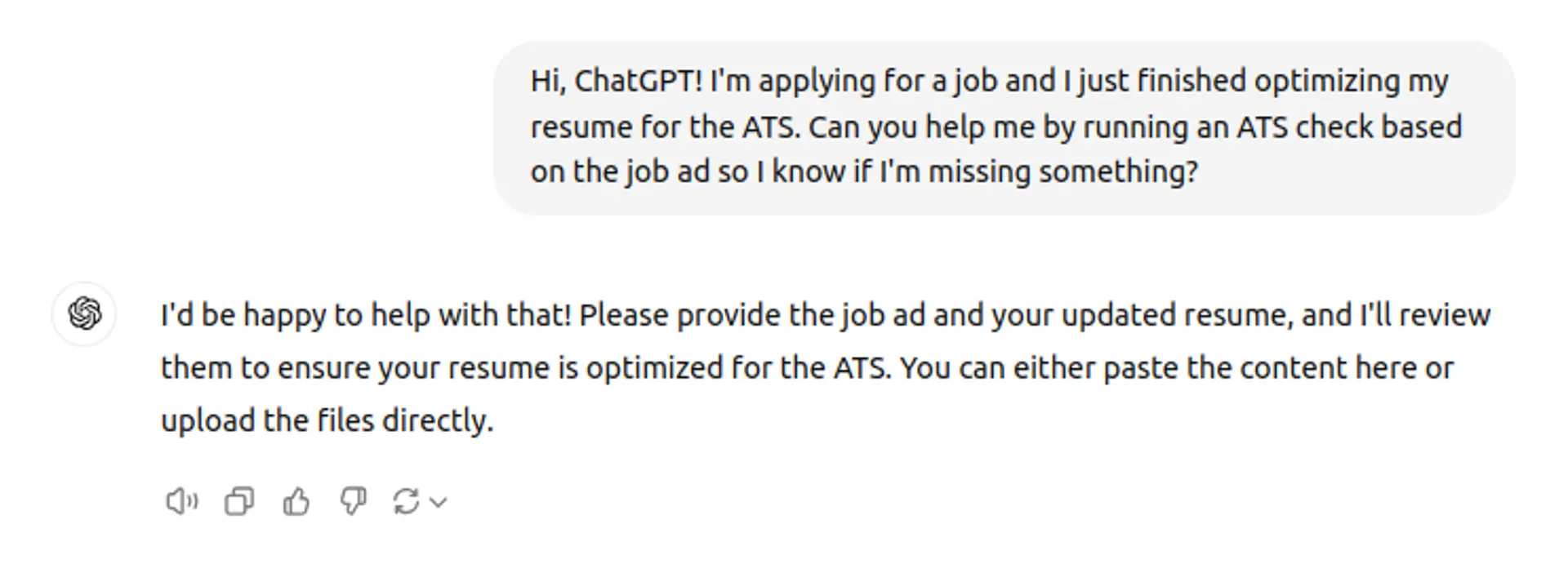
Next, upload the job ad along with your resume and ask ChatGPT to give you an approximate ATS score and suggest changes.
To give you an example, we compared a nanny's resume to a relevant job ad. This is what ChatGPT had to say:
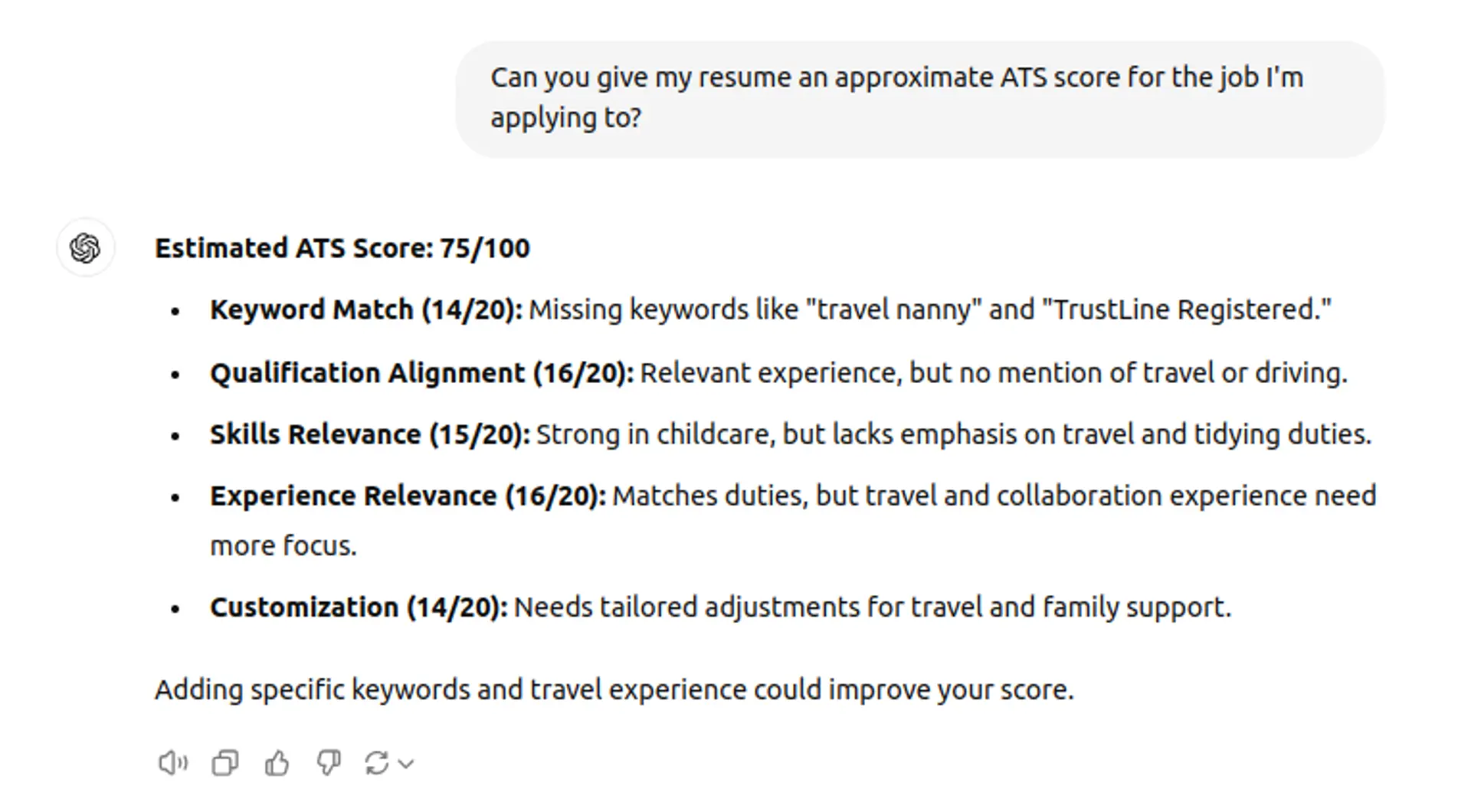
ChatGPT can easily spot what your resume might be missing, and once you incorporate its feedback, you’ll be ATS-ready in no time!
10 ATS Resume Templates for 2026
Want to make an ATS-ready resume without the hassle of formatting everything by yourself? Just pick one of our templates below:
#1. General Resume Template
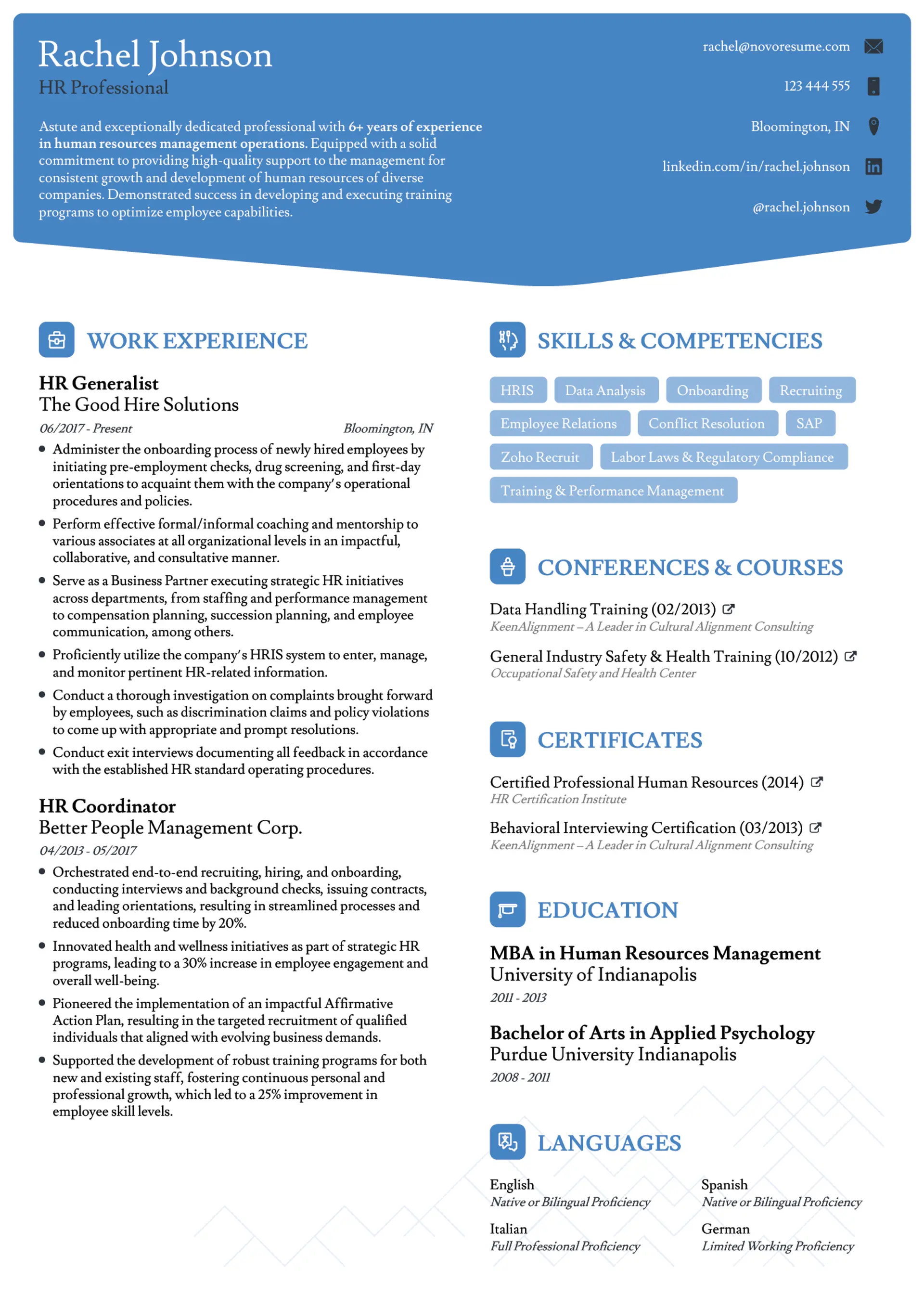
#2. Tech Resume Template
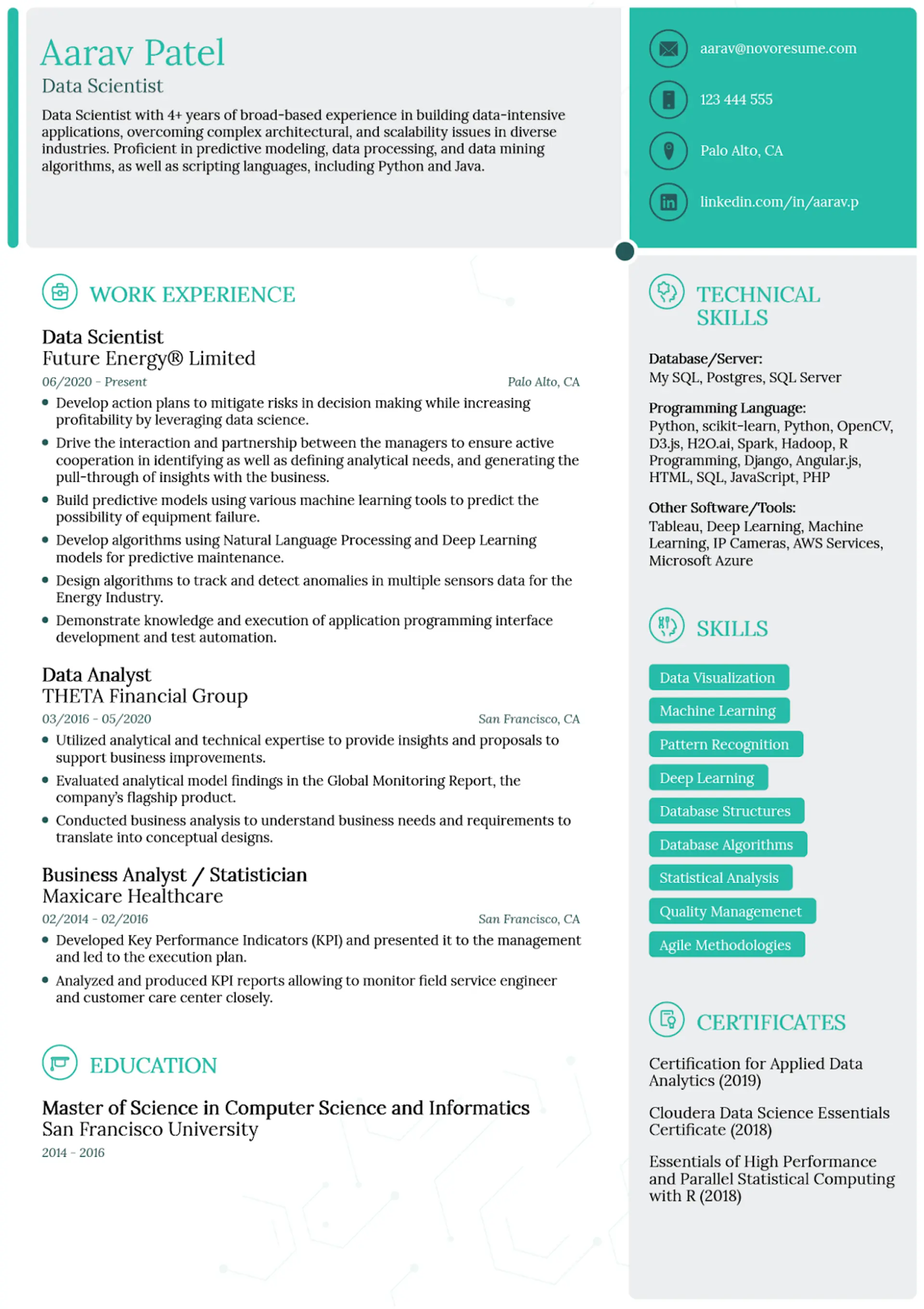
#3. Functional Resume Template
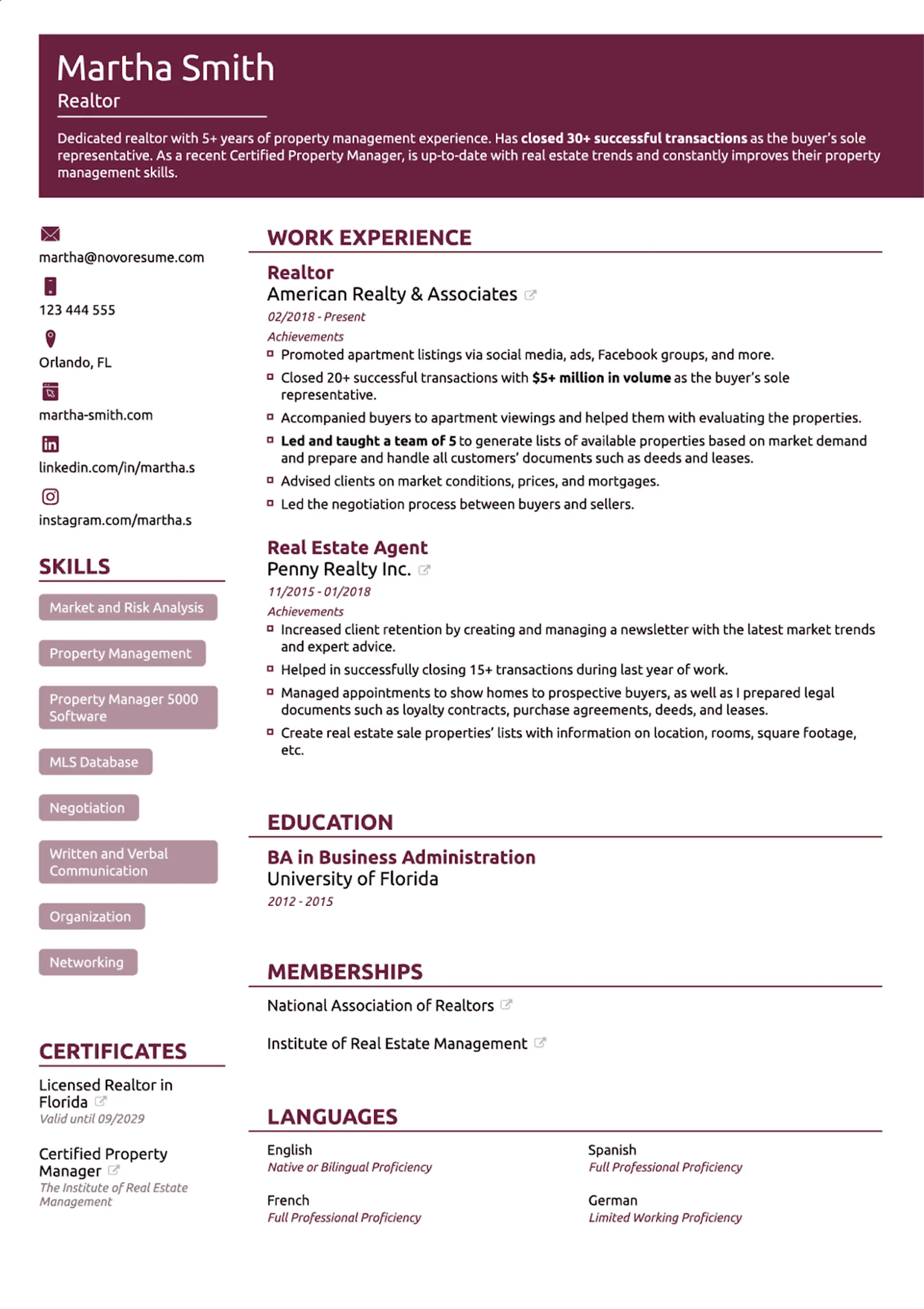
#4. Simple Resume Template
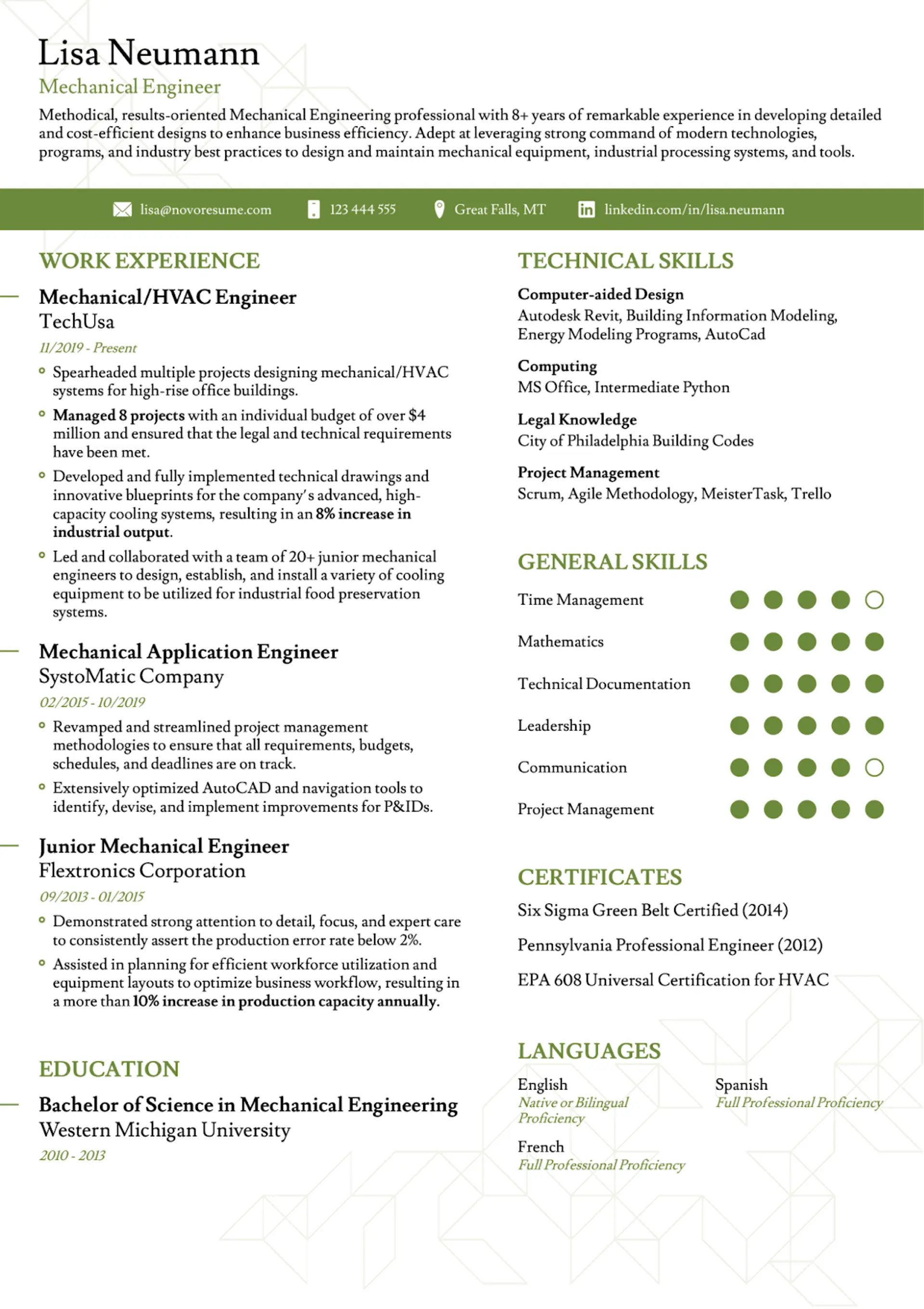
#5. Executive Resume Template
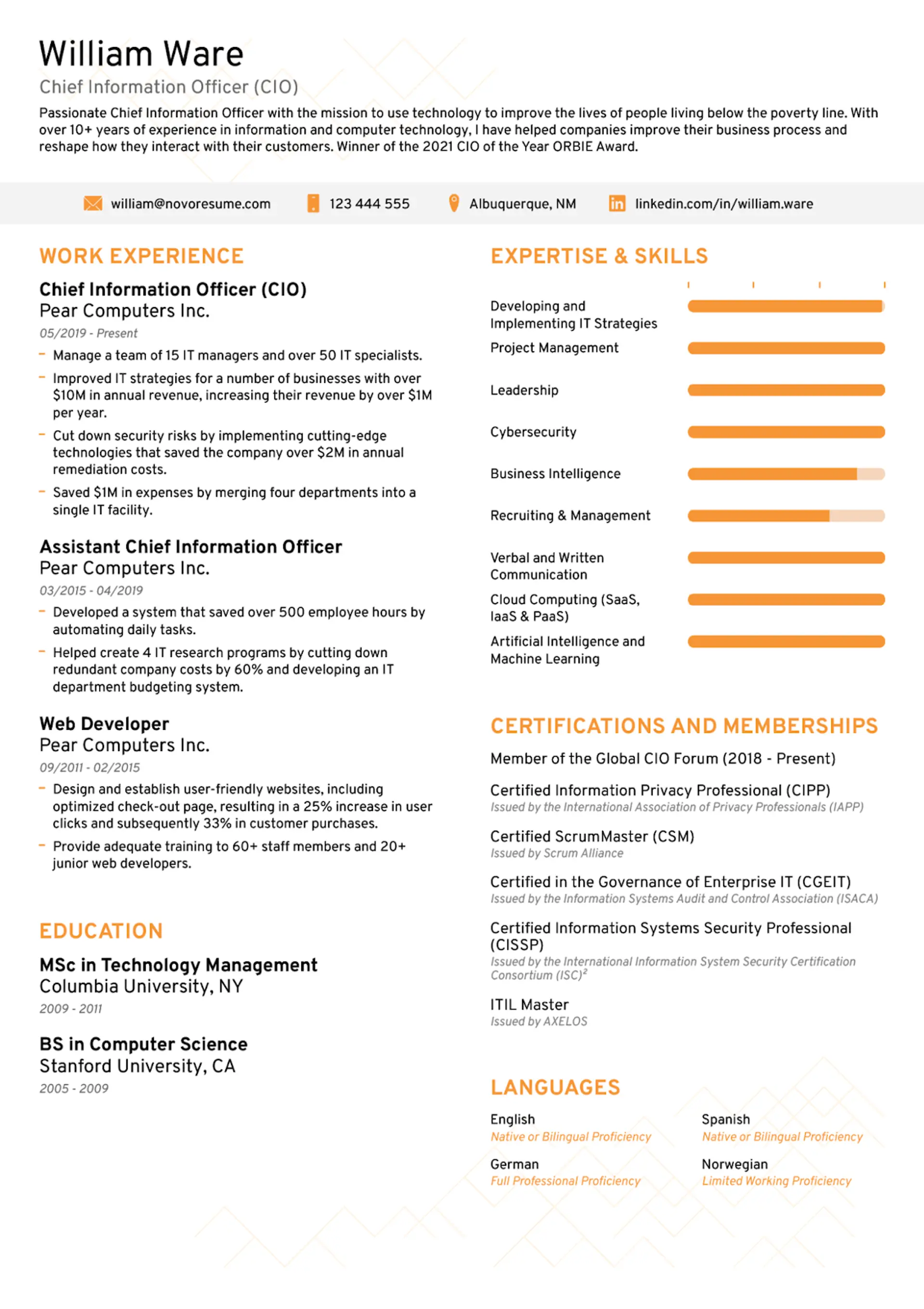
#6. Traditional Resume Template
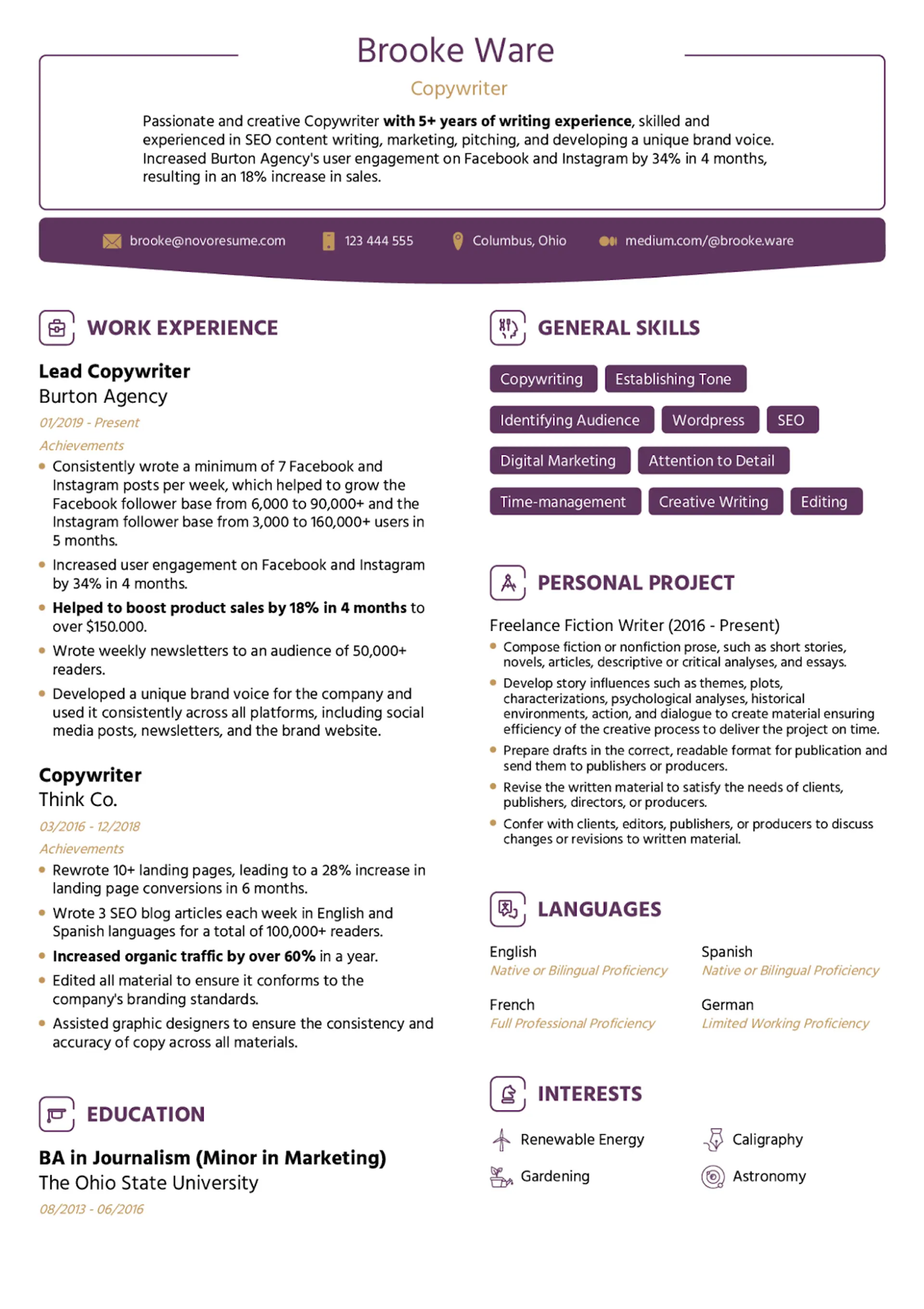
#7. Minimalist Resume Template
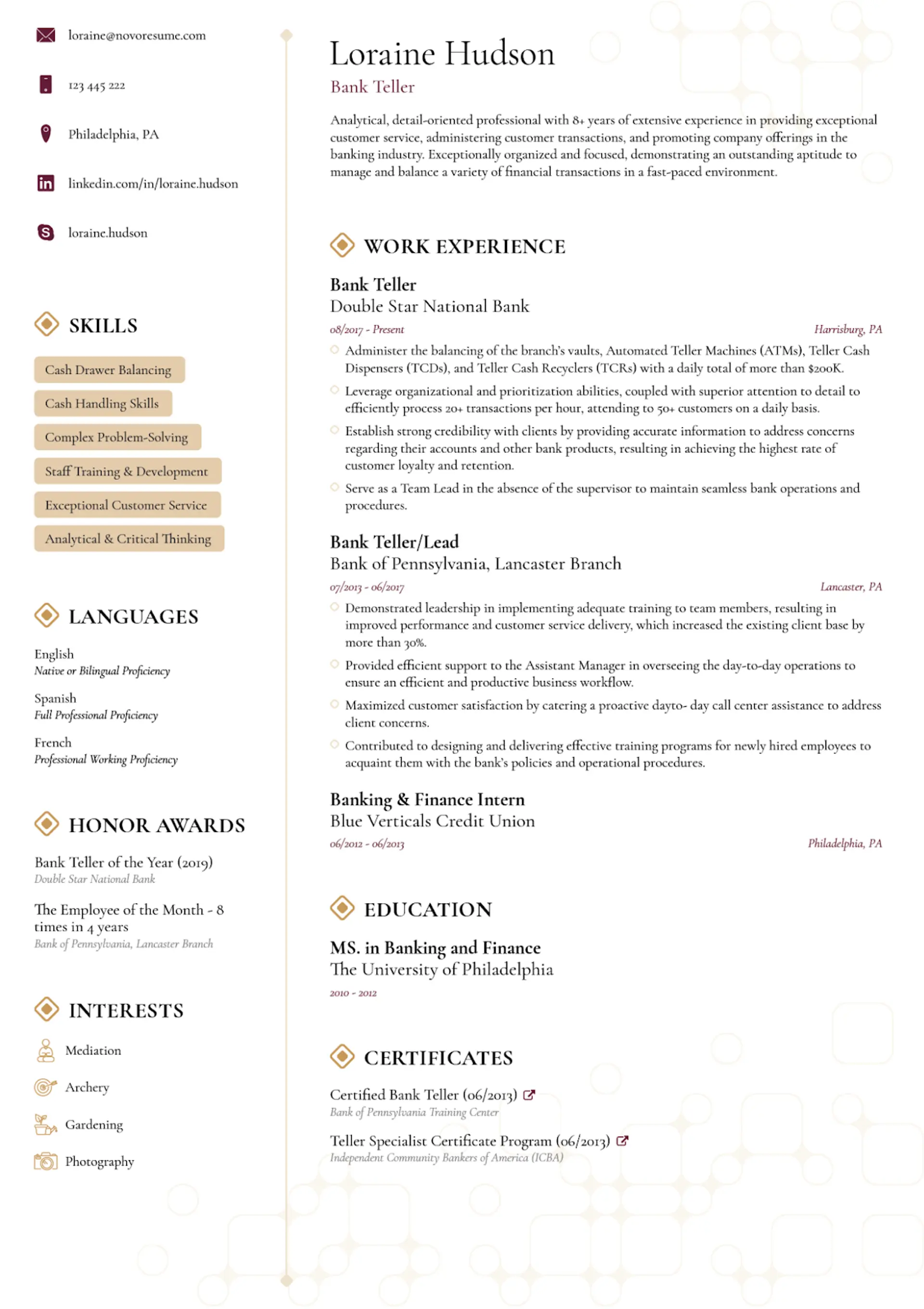
#8. Basic Resume Template
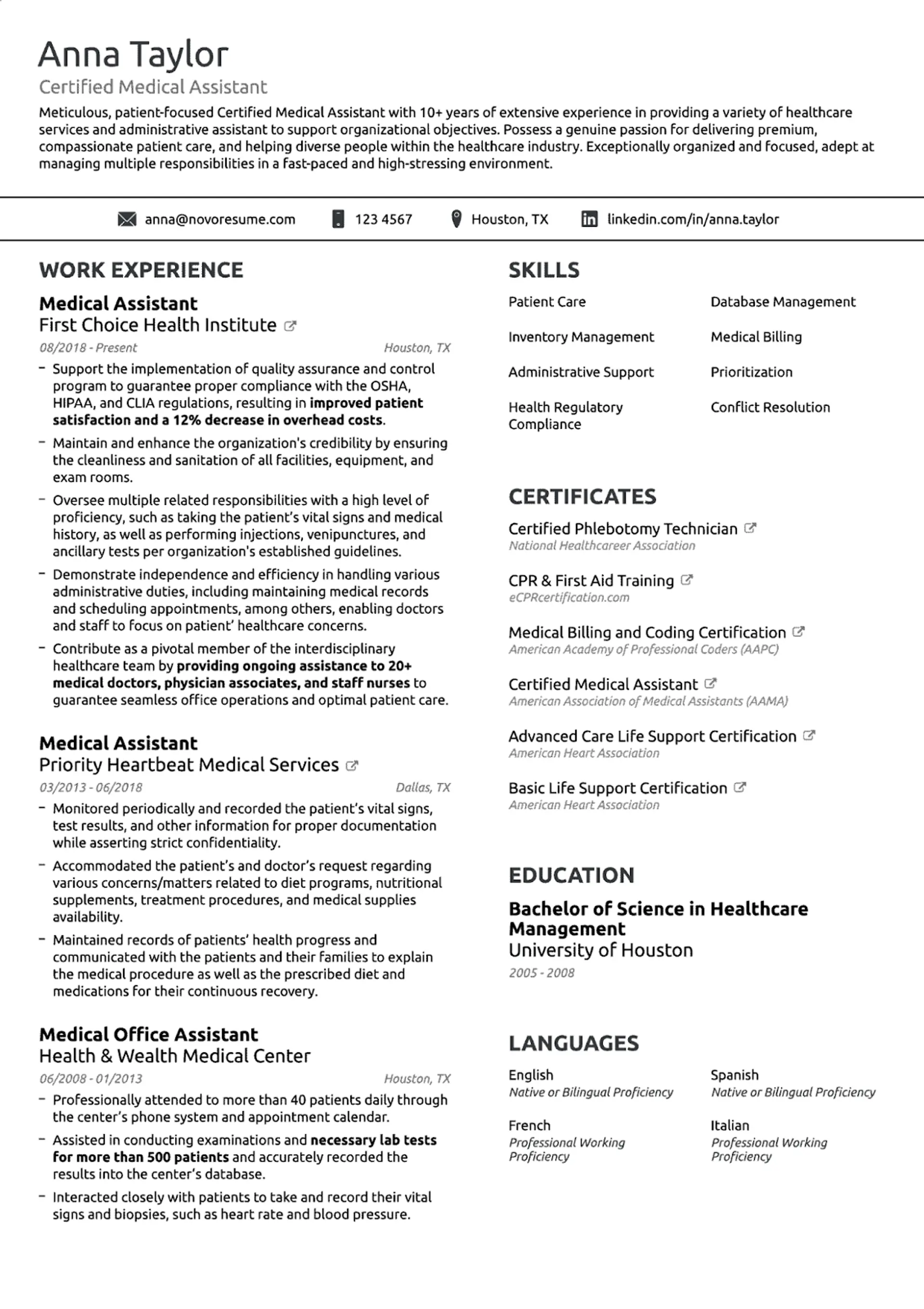
#9. Creative Resume Template
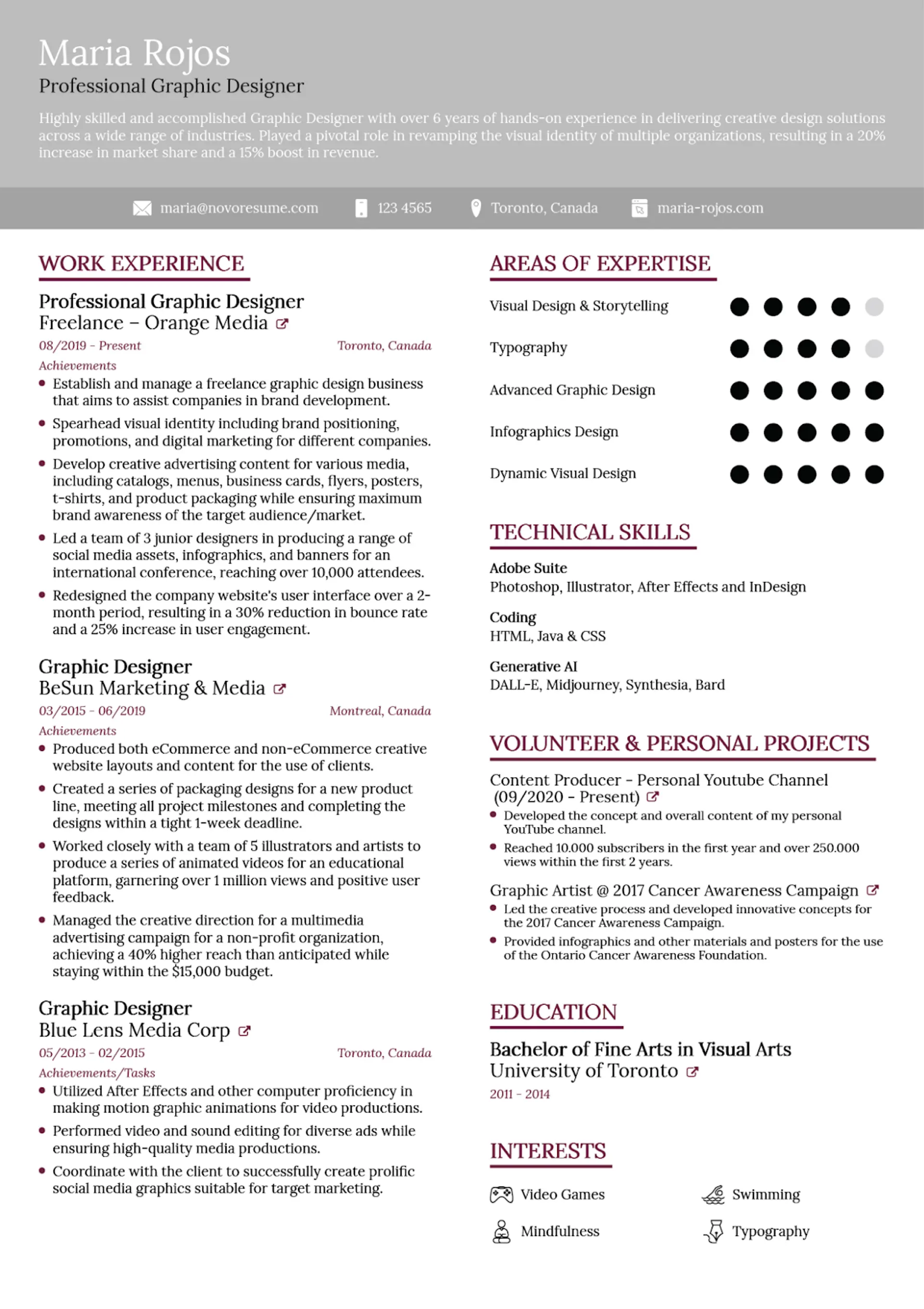
#10. Modern Resume Template
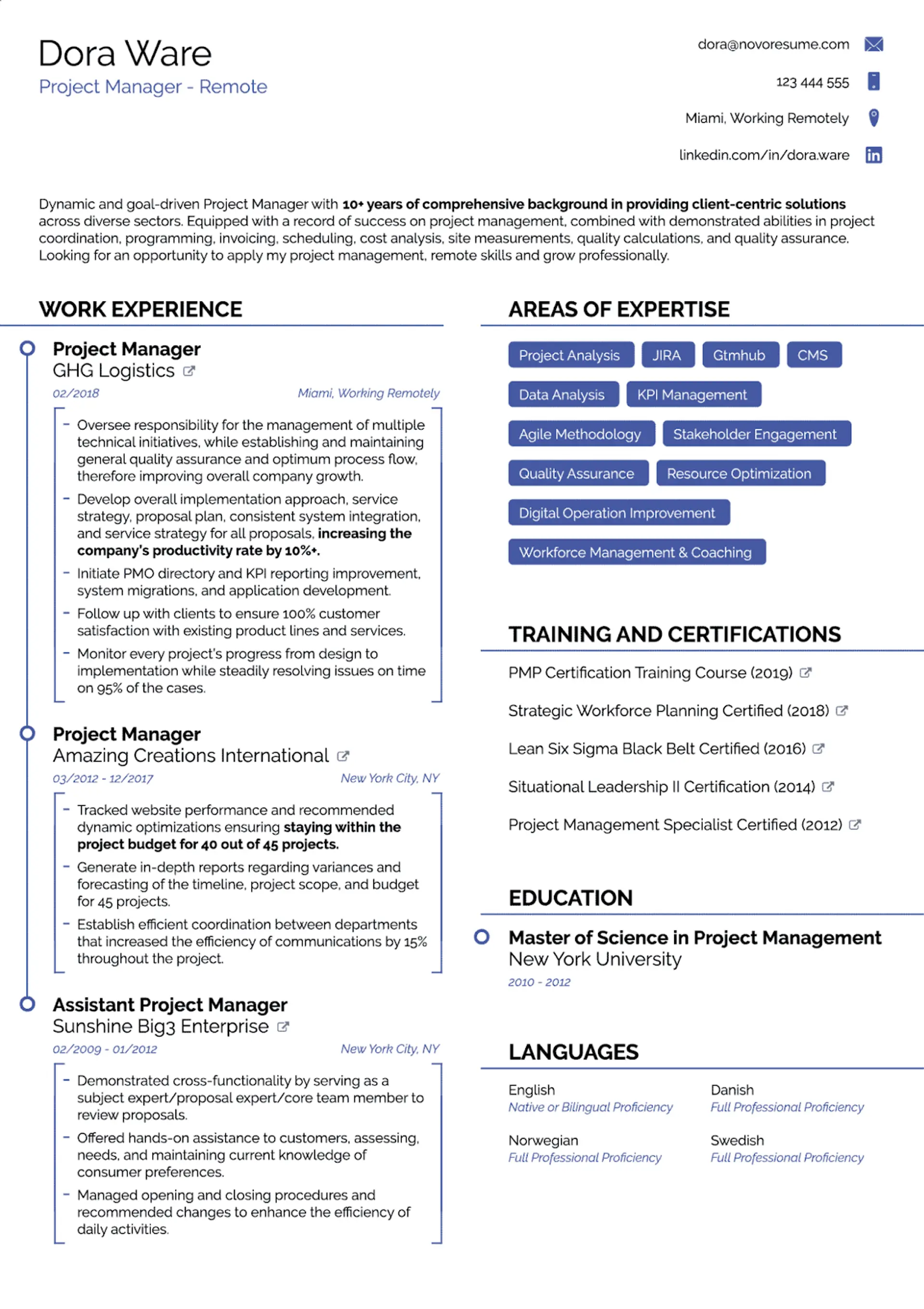
💡
Quick Tip
Looking for more inspiration? Check out these ATS-friendly resume templates for more!
FAQs on ATS Resumes
Are you still wondering something about ATS resumes? Check out the answers to some of the most frequently asked questions below:
Key Takeaways
You’ve made it to the end of our article! Woo-hoo!
But before we celebrate you beating the ATS in your next job application, let’s do a quick overview of what we learned in this article:
- Most companies use Applicant Tracking Systems (ATS) to manage the application process. This is a system that collects, scans, and ranks your resume according to how well it matches the job description.
- ATS makes work easier for recruiters and hiring managers but harder for candidates. Over 70% of job-seekers fail the first screening, which the ATS handles.
- There are a few ground rules to making an ATS-friendly resume. Use a reverse-chronological resume format and keep your design simple so the ATS can easily read through your whole resume.
- Keywords are at the heart of beating the ATS. The software scans the documents you submit for keywords, so the more keywords you include, the better your application ranks.
- Don’t just stuff keywords into your resume - at the end of the day, a human hiring manager is going to read it, and if they see a keyword salad, you’ll get a manual rejection instead of an automatic one from the ATS.
- Write an ATS-optimized cover letter to impress the hiring manager and increase your chances of getting an interview.
